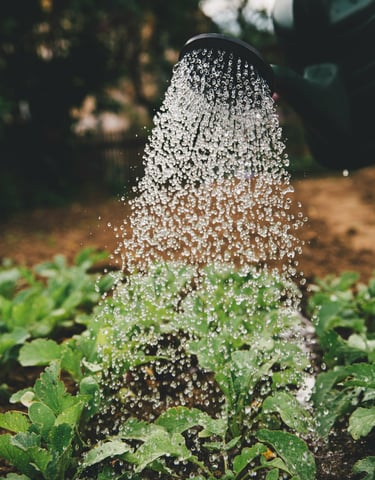Plants - Water requirement
Understanding water requirement in plants
1/25/20243 min read


Water is a must we know....but in Right Quality, Quantity, and Way
Why water is required :
Germination – Water is required to activate the process of germination, also to soften the seeds for the plants to break through.
Photosynthesis - Process by which plants make energy to grow. It requires sunlight, water, and carbon dioxide
Nutrient transfer – Plants need water to absorb nutrient
Transpiration - Transpiration is the process of water movement through a plant and its evaporation from aerial parts, such as leaves, stems and flowers. It is a passive process that requires no energy expense by the plant. Transpiration also cools plants, changes osmotic pressure of cells, and enables mass flow of mineral nutrients
The water requirement varies as below :
a)Plant- Different plant have different requirement
b)Climate – Humidity, temperature, wind
c) Growth stage – In general the more grown stages need more water
Some inputs for Right Quality, Quantity, and Way.
pH, EC, TDS : Just like our body water quality is important to plants as well
a. pH – In case of human body water is recommended in tight range of 6.5 -8.5. For plants it is slightly acidic in general between 5.5-6.5 (Varies plant to plant) - If the pH level is too high or low, it can make it difficult for plants to absorb essential nutrients, leading to stunted growth and yellowing leaves. Same can be adjusted and measured
b. TDS and EC – Like human body plants are also impacted by higher TDS and EC. High dissolved solids impact nutrition absorption and also can have harmful substances dissolved in water impacting health of plant. In general TDS should be less than 500ppm for better health. If TDS is high it has to be lowered (Methods : RO, Distillation, Deionization, Ion exchange, Electrodialysis, Chemical treatment, Dilution). Practically, if RO water is available mix RO water with tap water so that TDS is below 500. TDS meter is easily available at low price and same is useful not for plants but to measure water we drink as well.
2. When to water :
a. We take thirst as indicator in our case, For plant we can take soil wetness as indicator. If top surface (1-2”) is dry, plant needs watering. Climate impacts evaporation and water usage hence watering need changes. For e.g. In rainy days it is not even required to water for 2-5 days.
b. Research and experience indicate early morning (or before 10 am) is best time to water, gives more time to plants to absorb water. Alternatively, late afternoon is good. We should avoid peak sun hours as it may have adverse impact on growth
3. Large size pots absorb more water and can retain wetness longer. Accordingly, the smaller the size frequency is more
4. It is better to water thoroughly and spread frequency rather than small water quantity
5. Underwatering may be ok but overwatering is harmful and can impact survival of plant. Never overwater plants. Stop watering when water drains out from drainage holes. Waterlogging can damage roots
6. Potting mix is important as they help regulate water better and allows better nutrient absorption by plants
7. Always water around the plants and distribute in entire area and without splash to avoid soil erosion. Also, wet leaves to be avoided as wet leaves invite disease manifestation.
8. Watering depends on type of plant also. Some plants like wet soil, some like mild moisture and some like cactus, use to be happy if neglected. So, check the requirements of your plant and then only make a watering schedule.
Contact us
sonia.greenoura@gmail.com
Digital presence
(+91) 9667476590
We have with us proven packaging and shipment partners to deliver products pan India. It is important to us that product reaches you properly.
In case of damage during shipment, just share an unboxing video on WhatsApp, either replacement or refund will be done. No hidden charges. No questions asked
